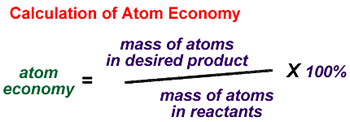Yield and atom economy of chemical reactions
0.0(0)
0.0(0)
Card Sorting
1/7
Study Analytics
Name | Mastery | Learn | Test | Matching | Spaced |
|---|
No study sessions yet.
8 Terms
1
New cards
Why is it not always possible to obtain the calculated amount of a product?
- the reaction may not go to completion as it is reversible.
- some of the product may be lost when it is seperated from the reaction mixture.
- some of the reactants may react in ways different to the expected reaction.
- some of the product may be lost when it is seperated from the reaction mixture.
- some of the reactants may react in ways different to the expected reaction.
2
New cards
Define theoretical yield
The maximum possible mass of a product that can be made in a chemical reaction.
3
New cards
Define actual yield
The mass of a product actually obtained from the reaction.
4
New cards
Why is actual yield always less than theoretical yield?
- Incomplete reactions, so some of the reactants do not react to form the product.
- Practical losses during the experiment, like during pouring or filtering.
- Side reactions (unwanted reactions that compete with the desired reaction)
- Practical losses during the experiment, like during pouring or filtering.
- Side reactions (unwanted reactions that compete with the desired reaction)
5
New cards
Percentage yield =
actual yield / maximum theoretical yield x 100
6
New cards
What is atom economy?
A measure of the amount of starting materials that end up as useful products.
7
New cards
Percentage atom economy =
relative formula mass of desired product / sum of relative formula masses of all reactants x 100

8
New cards
CH4(g) + H2O(g) → 3H2(g) + CO(g)
Calculate the atom economy for the reaction for H.
(Ar of H = 1, Ar of C = 12, Ar of O = 16)
Calculate the atom economy for the reaction for H.
(Ar of H = 1, Ar of C = 12, Ar of O = 16)
1. Find Mr of reactants.
Mr of CH4 = 12 + (4 x 1) = 16
Mr of H2O = (2 x 1) + 16 = 18
Total Mr of reactants = 16 + 18 = 34
2. Find Mr of desired product.
Ar of H2 = (2 x 1) = 2
Total Mr of desired product = 3 x 2 = 6 (as there are three H2's)
3. Plug into equation.
Atom economy = Mr of desired product / Mr of all reactants
Atom economy = 6 / 34 x 100
Atom economy = 17.6%
Mr of CH4 = 12 + (4 x 1) = 16
Mr of H2O = (2 x 1) + 16 = 18
Total Mr of reactants = 16 + 18 = 34
2. Find Mr of desired product.
Ar of H2 = (2 x 1) = 2
Total Mr of desired product = 3 x 2 = 6 (as there are three H2's)
3. Plug into equation.
Atom economy = Mr of desired product / Mr of all reactants
Atom economy = 6 / 34 x 100
Atom economy = 17.6%